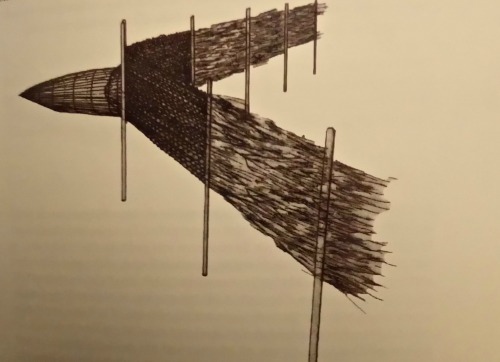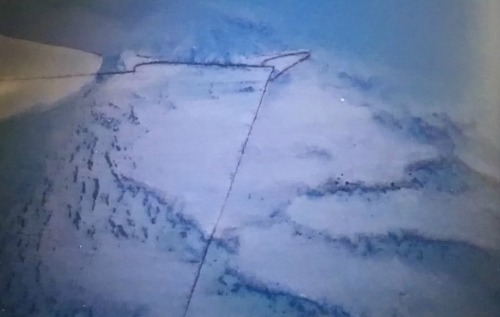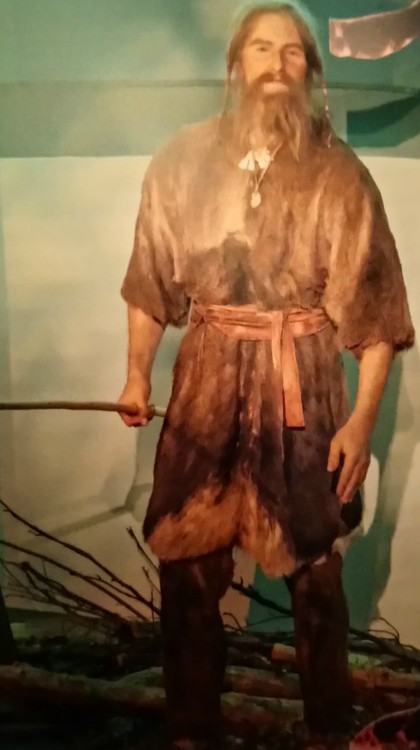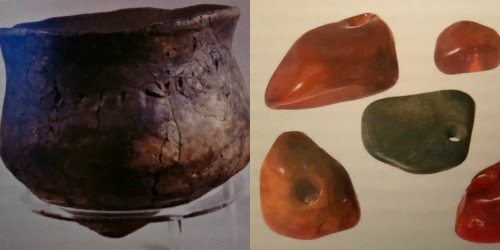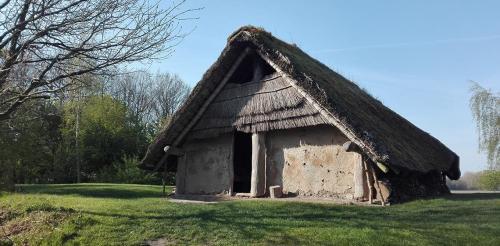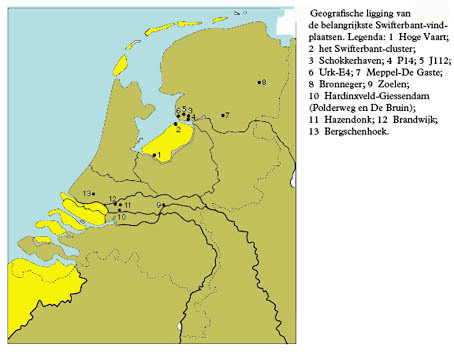#swifterbant
Swifterbant Fishing
Between 1999 and 2001, the remains of at least 10 fish barriers and 40 fish traps have been found in modern day Flevoland, the Netherlands dated back to around 3000BC which belonged to the Swifterbant culture, about which I wrote a post earlier this week. This fishing gear has been conserved very well. Perhaps because Flevoland was first land, then a lake, then sea and now land again.
The fish barriers in particular are special because they show that these people were very skilled at fishing thousands of years ago. They didn’t simply use a spear or a rod to catch a fish, they made complicated traps in order to lure and trap fish.
The barriers are around 15 to 30 meters long and were shaped like a funnel. Fish could swim into the barrier but they couldn’t get out again. The fish traps were made from willow branches and the poles supporting the barriers were made from birch, elm and hazel wood. The willow branches were woven and bound with a rope made from bark.
Several long, 2 meters long, taxus wood sticks have been found as well which were most likely used to keep the traps in place. This highly efficient way of fishing probably led to a surplus of fish for these mesolithic people. This makes archeologists wonder if they just caught fish for their own consumption or did they also catch it to use for trade?
Were they able to smoke the fish and transport it to other settlements for trade? Evidence for the use of small ships like canoes have been discovered as well near these Swifterbant settlements like peddles. Unfortunately direct evidence of trading this fish is gone by now but it might be very much so possible that these prehistoric people not just caught fish for food but for trade as well, which is a rare thing to see in mesolithic societies.
The way how these Swifterbant people used these fish barriers to fish has not changed for over 5000 years. Fishers in the Netherlands still use this exact same method until this day. It’s a nice prehistoric tradition that still exists today so I thought it would be interesting to share.
Here are photos of:
Swifterbant fish barrier found,
Swifterbant fish traps,
Reconstruction of the fish barrier,
Modern day Dutch fish barrier,
Canoe peddle found,
Post link
Swifterbant Culture
The Swifterbant culture is a prehistoric culture that developed around modern day Flevoland, the Netherlands. Traces of this culture have also been found more to the south and in Germany. Swifterbant people lived between 5000BC-3400BC and they are fascinating because these people were hunter and gatherers who developed agricultural skills. Proof that the second wave of migration into Europe, people who were farmers, from around 7000BC, did not just replace the hunter gatherers. Agriculture developed on its own as well.
This prehistoric culture was discovered by J.J Aukema in 1962. Flevond was still being created, barely 30 years earlier the Afsluitdijk was build, turning the Zuiderzee into a big lake. After the first pieces of pottery and flint arrowheads were discovered by Aukema, A large archeological research was conducted in the area during the 1970’s. Several settlements were discovered from people who used to live here 7,000 years ago.
It is hard to imagine how modern day Flevoland used to be a rich landscape with dunes, swamps, forests and creeks. This rich landscape turned into a lake called the Flevomeer around 500BC before turning into a sea called the Zuiderzee. This sea existed until 1932 when the Afsluitdijk was build, turning the sea into a lake once more. A large part of the lake was drained and thus the modern province of Flevoland was created.
In total, 14 Swifterbant settlements have been discovered in Flevoland during the draining of the land. Only two of these settlements have been dug up, the other 12 have been carefully researched without disturbing the land.
The Swifterbant people were originally hunter and gatherers who enjoyed the rich flora and fauna. The area was lush and filled with all kinds of wildlife, perfect for a stone age hunter and gatherer culture. Raising sea levels however slowly started to change the landscape and the ground was getting wetter and wetter. The lush forests with its creeks disappeared and changed into swamps.
This change in landscape could have been the reason why these prehistoric people started to experiment with agriculture. The rich fauna disappeared thus so did most of their food supply. They were forced to either move to a new area or try to cultivate their own food.
This Swifterbant culture is almost exactly similar to the Scandinavian Ertebølleculture. Both cultures developed around the same time, 5600BC. They are in fact so similar that it is almost impossible to see cultural differences. The biggest difference is that the Swifterbant culture started to keep cattle thousand years before the Ertebølle culture did. The Swifterbant culture and the Ertebølleculture developed into the Funnelbeaker culture around 4300BC.
I have written a post about this culture back in September for those who are curious. One of the most interesting finds of this culture was discovered in 2018. The remains of a young woman with a baby in her arms. This baby is the oldest baby ever found in the Netherlands. DNA research confirmed that the woman was the mother of the baby and the baby was a female.
Now for those people who are curious about the meat diet of a mesolithic hunter and gatherer human, here is a list of animals used/eaten by the Swifterbant people. You can see that their diet was quite varied, this is thanks to the rich fauna that lived in the area and the lush landscape. Of course fruits and vegetables were eaten as well.
Pets: Pig, cattle, sheep, goats and dogs
Hunted animals:Wild boar, Beaver, Red Deer, Otter, Elk, Roe deer, Badgers, Wild Cat, Fox, Polecat, Weasel, Mole, Brown Bear, Auroch, Horse, Sea Lion.
Fish:Garfish, Catfish, Bream, Roach, Tench, Sea Bass, Sturgeon, Eel, Salmon
Birds:Wild Duck, Geese, Swan, Crow, Jay, Sea Eagle, Crane, Seagull, Cormorant, Grebe.
Here are photos of: Swifterbant male reconstruction, Swifterbant female and baby skeleton, Swifterbant Farm, Swifterbant tools, pottery and jewelry, A map that shows Swifterbant finds
Post link



